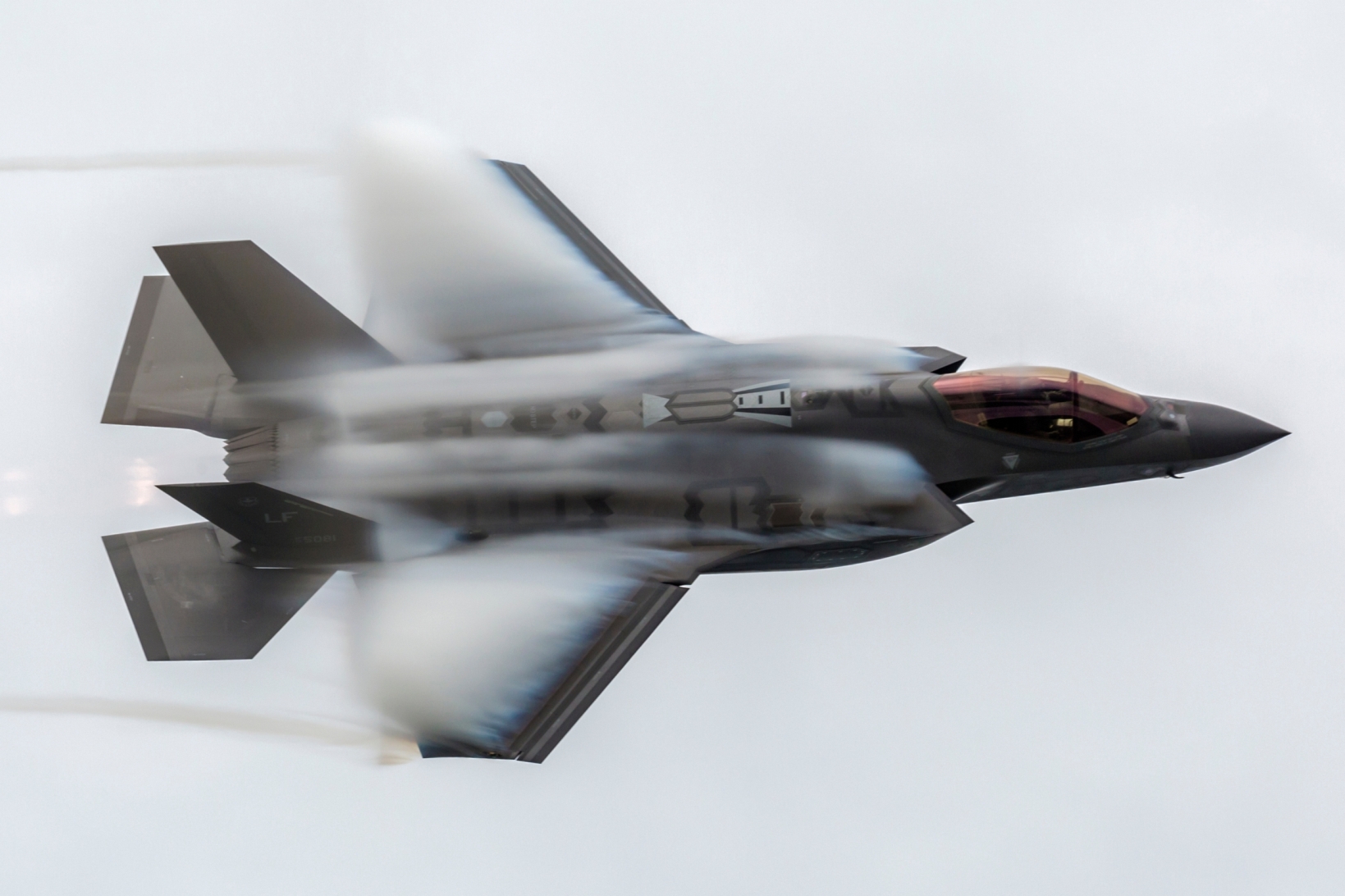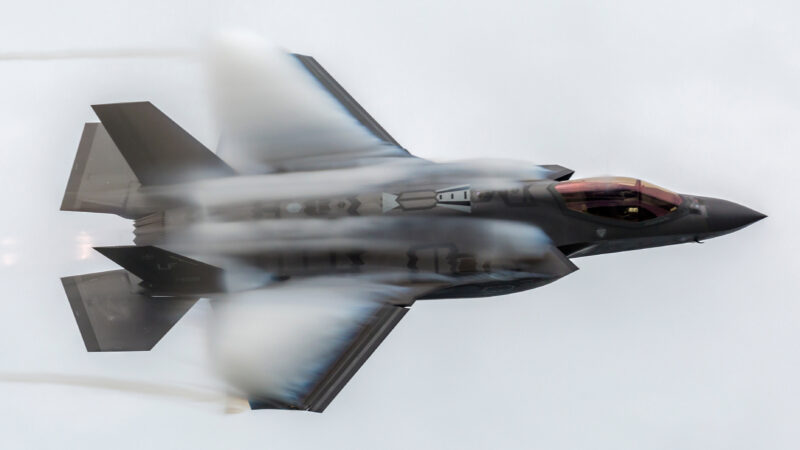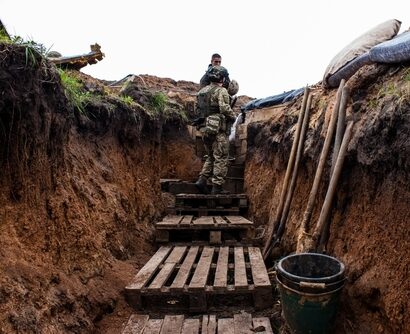Abstract: Let´s take a closer look at the future of air-to-air warfare and the F-35 Joint Strike Fighter, the fifth-generation replacement for the aging fleet of western, mostly US-built fourth-generation (4, 4+, 4++) fighter aircraft. A direct comparison between the two generations would not be sensible due to the different concepts and philosophies of each. Fifth-generation means stealth capable. That capability changes the way of warfare entirely.
Bottom-line-up-front: The F-35 will yet have to prove if it really is (or will be) capable of replacing 4th generation fighters like the F-15C & E, F-16, F/A-18 (legacy and Super Hornet) and F-117.
Problem statement: How to fairly assess the potential impact of the F-35 on air-to-air warfare in the context of the heavy criticism the program has faced? How to understand this negative criticism the F-35 program gets publicly confronted with?
So what?: The (potential) operators of this new airframe should rethink their strategy and refrain from phasing out their generation 4, 4+ and 4++ airframes too soon, before the F-35 and its inherent logistics and supply chain will be completely operational.

Source: shutterstock.com/BlueBarronPhoto
The Air Force as a cost-driver
Ever since the beginning of aviation, the value of deploying aircraft in combat to fulfill many different roles has been apparent. Rapid advances in technology were always seen in the military, especially with regards to the advancement of combat aircraft. Today this pattern continues. As a result of the longstanding emphasis on aviation, many countries around the globe devote a remarkable amount of national funds to the maintenance of their armed forces. For some it is enough to simply keep their forces up to date; for others, it is a priority to keep their technology at the highest possible state of the art. The price of this continuous renewal is high, and other branches of the military are often held on a short leash as a result.
The F-35 project is a prime example of this phenomenon. Its development history dates back to the year 1996, when the actual development contract was signed. The first flight of the prototype already occurred four years later, in 2000. The first F-35s (USMC F-35B variant) became operational in mid-2015. That is quite a time span, but not uncommon in the development of new military equipment. After all, the incredible financial investment is supposed to “fit the bill” for decades to come. And here lies the problem. This single platform offered in three different variants (conventional take-off and landing F-35A (CTOL), short take-off and vertical-landing F-35B (STOVL), carrier-based F-35C (CV/CATOBAR)) is supposed to be an “all-in-one solution” that will fit three different branches within the US armed forces and numerous NATO and allied forces around the globe. This single airframe in its three different variants is intended to take over the roles of a multitude of fourth-generation fighters (including 4+ and 4++)[1] in use today. That usually means the aircraft cannot specialize at specific tasks, but will rather be able to perform a wide array of duties adequately.
It has been argued by some that the F-35 may be the last manned fighter aircraft designed.[2] Unmanned aircraft are already in the pipeline. The “loyal wingman” project from Boeing, for example, is a multirole, unmanned aerial vehicle with stealth capabilities that will be used as a “force multiplier” flying alongside manned aircraft to perform missions autonomously, controlled by artificial intelligence.[3] The next logical step in the view of the developer will be getting rid of the “weak link” also known as the human being for all combat airframes. The question is whether society is ready for unmanned aerial vehicles fighting against each other in conflicts or being used to fight against a human enemy. That ethical question remains to be analyzed yet.
The next logical step in the view of the developer will be getting rid of the “weak link” also known as the human being for all combat airframes. The question is whether society is ready for unmanned aerial vehicles fighting against each other in conflicts or being used to fight against a human enemy.
But why is the F-35 project so controversial? Dissenters claim that the F-35 actually lacks in speed and maneuverability compared to generation 4, 4+ and 4++ aircraft, which would not bode well for the cost justification of the new project if true.[4] This negative press may have damaged the reputation of the F-35 before it could prove itself through extensive use in conventional combat.
Shortcomings in replacement parts due to the not yet fully established logistics and supply chain for the F-35 pose a further potential risk and could lead the airframe to be deemed as not combat-ready. In response to this challenge, several operators, most notably the US, are pushing hard to stay within the planned operational timeframe.
Concept-spoiling as a pattern?
This negative campaigning has happened before with different airframes. One of the more recent cases was the Eurofighter Typhoon, which has received a lot of bad press but has proven to be a quite capable, albeit pricey, airframe. Many will remember the lawsuits and teething problems of the early stages of the F-16, which turned out to be a very capable best-seller that has undergone numerous modernizations to stay at the very cutting edge of technological advancement. It is relevant to mention that every aircraft that has been built in the history of aviation has received criticism. Everybody is aware of “teething problems“ or “growing pains” which means that no matter how advanced technology is, you won’t get it right the first time. Everything can be designed on computers nowadays, where every item and part of the hardware can be simulated and tested, before it is built. Nevertheless, there will still be design flaws and errors that can only be found once the airframe is being put together and tested in flight.
One of the more recent cases was the Eurofighter Typhoon, which has received a lot of bad press but has proven to be a quite capable, albeit pricey, airframe.
For all of its advancements, the F-16, as all fourth-generation fighters, must eventually come to an end due to a significant shortcoming: the lack of stealth capabilities. However, stealth technology is expensive, very much so. Not every country is capable or willing of paying the prize for stealth technology. Not every combat situation actually requires stealth either. It is a possibility to gain an advantage by “sneak in unseen, do your thing and get out unseen”.
However, once the advantage of stealth is gone, when the opponent has made visual contact, the story becomes different. In beyond visual range (BVR) fights where “fire and forget” missiles have been fired and have not reached its designated targets, for whatever reason (spoofed, jammed, ran out of fuel, etc.), it still comes down to who has got the “better” aircraft in the sense of maneuverability, speed, acceleration, weapon carrying capability, survivability, etc. since the fight will end up in a “dogfight”. I have never flown any of the F-35 variants in real life or simulations, so I can only examine what I have heard from fellow F-35 and non-F-35 pilots. The F-35 community is very persuasive in explaining where the F-35s strengths lie – stealth, durability, endurance and its multi-role capability. On the other hand, fellow 4, 4+ and 4++ generation fighter pilots comment that the F-35 isn´t worth the money in any respect. It is reportedly not as fast or maneuverable as an F-15 or F-16, and hasn’t quite got the firepower and weapon carrying capability of the A-10 or the F/A-18.
The F-35 community is very persuasive in explaining where the F-35s strengths lie – stealth, durability, endurance and its multi-role capability.
The plane of the future
So, is the F-35 a good “dogfighter”[5]? Among other updates, the F-35 no longer uses a Heads-Up Display (HUD). Instead it uses a technology far more advanced than the Joint Helmet Mounted Cueing System (JHMCS), which already is a technological marvel. The F-35 pilot helmet uses a Helmet Mounted Display System (HMDS), which projects all relevant and desired information right into the pilots´ field of view, no matter where the pilot is looking, be it right down through the cabin floor or anywhere through the aircraft’s fuselage. The HMDS is a combination of many high-tech display features: a virtual HUD, digital night vision, distributed aperture system, cueing of sensors and weapons (boresight), target designation, defensive system, encrypted datalink, plus the capability for later HMD advancements. All that encompassed in one “light weight” (dropped from 5.1 to 4.6 pounds) helmet system greatly enhances the pilot´s situational awareness (SA). SA is the most crucial skill for crews in military aircraft. It is a matter of survival. The more systems you have that help you maintain your SA or even help increase your SA, the better. And that is also the main argument from everybody involved in the F-35 program – even though it might not be the fastest fighter jet around or the most maneuverable, it is certainly one of the most or even the most pilot-friendly fighter, SA wise currently flying.
The benefits of the F-35 don’t stop there. While fourth-generation aircraft are very capable and “affordable” compared to their successors, they have to carry a lot of their sensors and equipment externally, thus preventing them from being stealthy. The corresponding aerodynamic drag increases with every item that is “hanging” outside the aircraft, reducing its tactical radius by increasing fuel burn. Stealth aircraft on the contrary carry all of their fuel, ordnance, and sensors internally, which keeps their radar signature (radar cross section) as small as possible. That is especially beneficial when the mission calls to operate undetected, e.g. during reconnaissance or precision strike missions in highly defended areas. Whenever stealth is not required, fuel tanks or extra ordnance can be mounted externally to enhance the combat radius or weapon load. The F-35 relies on stealth. F-35s, employed correctly in battle, would score most of their kills with long-range missiles fired from beyond visual range.[6]
F-35s, employed correctly in battle, would score most of their kills with long-range missiles fired from beyond visual range.
Why does the F-35 then lose dogfights with fourth generation fighters? Well, there are some explanations. For one, it is a new system: the new airframe, new power plant, new electrical systems, sensors and pretty much everything in the aircraft is new. As with any new system there are “teething problems” in the beginning. Everybody who works with computers is aware of the constant upgrades and software updates programs require. There is no difference to modern aircraft; in fact the biggest part of the development is not the hardware, but rather the software. That is a quick and simple explanation to why things are not going as planned yet and why all the legacy fighters seem to have no problem in air to air combat with the F-35. That of course will change as the software is gradually being updated and integrated within all systems and all bugs will be fixed over time.
Dominance with an uncertain future
But should that be of concern? Not according to some defense strategists and senior officials. The days of the “dogfight” are long gone and since the F-35 uses stealth technology it has a clear advantage. In a perfect world that might be true, but in the unlikely situation where the F-35´s weapons have been spoofed or not found their targets, the opposition will suddenly be very close, where everything ends up in a “furball” – a classic dogfight, where the F-35 won’t really excel compared to some modern Russian MiG (29, 35) and Sukhoi (27, 30, 33, 35) fighters. History has proven the days of the dogfight are by far not gone at all. It has happened many times before where long-distance “fire and forget” missiles have not reached their targets for whatever reason. In the time span of a few dozen seconds (supersonic aircraft closure speeds) the adversaries will find themselves once more confronted in a classic dogfight (aka knife fight in a phone booth) situation, where maneuverability still counts. Contrary to mainly US and NATO, Russian philosophy never dropped the dogfight scenario. Look at Russian hardware. Everything is extremely rugged and well-engineered in case the infrastructure (runways, airports) has been destroyed and the need to operate from unimproved landing strips (grass, gravel) arises, whereas in the west we tend to operate from “sterile” FOD (Foreign Object Damage) checked flight decks and runways.
Still, most NATO countries are replacing their fourth-generation airframes with fifth-generation F-35 variants. The biggest threat to this day, besides the asymmetric warfare of terrorism, comes, according to the US National Security Strategy, from countries like China and Russia. Their inventory still poses one of the greatest threats. A large-scale aerial engagement against enemies like that will be less than favorable for the F-35. Russian philosophy never distanced itself from air superiority and the dogfighting capability of their front-line fighters. US (NATO) philosophy got rid of guns on airplanes after Korea, since the thought was future engagements would happen at great distances utilizing radar and (fire and forget) missiles. Vietnam proved that decision to be wrong and guns were quickly put back onto airplanes (e.g. F-4 Phantom) and new advanced fighting courses, most notably the US Navy Fighter Weapons School (TOPGUN) and the USAF Weapons School were established.
A large-scale aerial engagement against enemies like that will be less than favorable for the F-35. Russian philosophy never distanced itself from air superiority and the dogfighting capability of their front-line fighters.
However, the critical turning point has already been reached; the latest results show a different picture about the capabilities of a very versatile platform that will greatly improve over time. The largest military contract in history involved the development of the F-35 Joint Strike Fighter. There is a lot of economic and political interest behind that program that will ensure it will become a success. More than 620 units have been built up to this day.
Nick Jost (Lt.Col. ret.) has 20+ years of international work experience in the armed forces (Navy and Air Force) as a fighter pilot and special forces operator, running his own aerospace, maritime and defense consultancy as well as working in numerous international projects. Mr. Jost has an academic background in aeronautical science and international relations. The views contained in this article are the author’s alone.
[1] An explanation to jet fighter generations:
– Generation 4: Pulse-doppler radar; high maneuverability; look-down, shoot-down missiles (F-14, F-15, F-16, F/A-18, Mirage 2000, MiG-29, Su-27).
– Generation 4+: High agility; sensor fusion; reduced signatures (Eurofighter Typhoon, Su-30, advanced versions of F-16 and F/A-18, Rafale).
– Generation 4++: Active electronically scanned arrays; continued reduced signatures or some “active” (waveform canceling) stealth; some supercruise (Su-35, F-15SE).
– Generation 5: Advanced integrated avionics, low observable stealth (F-22, F-35, Su-57, Chengdu J-20, Shenyang FC-31).
[2] Todd Harrison, “Will The F-35 Be The Last Manned Fighter Jet? Physics, Physiology, and Fiscal Facts Suggest Yes,” CSBA (April 29, 2015), https://csbaonline.org/about/news/will-the-f-35-be-the-last-manned-fighter-jet-physics-physiology-and-fiscal-.
[3] Boeing, “Boeing Airpower Teaming System,” Boeing (2020), https://www.boeing.com/defense/airpower-teaming-system/.
[4] Matthias Wasinger, “Airpower in the Twenty-First Century: Swing- and Multi-Role versus Single-Role Specialists,” Wild Blue Yonder (August 17, 2020), https://www.airuniversity.af.edu/Wild-Blue-Yonder/Article-Display/Article/2313184/airpower-in-the-twenty-first-century-swing-and-multi-role-versus-single-role-sp/.
[5] A dogfight is an aerial battle between fighter aircraft conducted at close range. The term dates back to WWI and the “Red Baron” Manfred von Richthofen. Modern terminology for air-to-air combat is air combat maneuvering (ACM), which refers to tactical situations requiring the use of individual basic fighter maneuvers (BFM) to attack or evade one or more opponents.
[6] Alex Lockie, “Dogfighting in an F-35 is ‘like having a knife fight in a telephone booth,” Insider (October 20, 2016), https://www.businessinsider.com/f35-dogfighting-knife-fight-telephone-booth-2016-10?r=US&IR=T.






